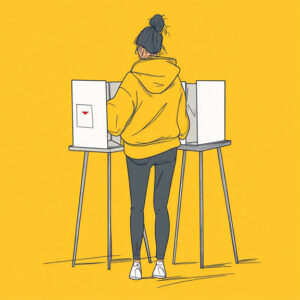 Being a philosopher and single once again, I have been overthinking the whole dating thing. The original version of this essay was written in 2016 after the amicable end of a long-term, long-distance relationship. This rewrite is being done in 2025 after then end of a long-term, long-distance relationship in 2024.
Being a philosopher and single once again, I have been overthinking the whole dating thing. The original version of this essay was written in 2016 after the amicable end of a long-term, long-distance relationship. This rewrite is being done in 2025 after then end of a long-term, long-distance relationship in 2024.
Back in 2016 a random interaction back when I was 50 provided me with something new, or rather old, to think about: age and dating. In this scenario I was talking with a woman and had no intention of making any overtures or moves (smooth or otherwise). With some storytelling license in play, we join the story in progress:
Her: Flirt. Flirt. Flirt.
Her: “So, what do you do for work?” Flirt.
Me: “I’m a philosophy professor.”
Her: “At FSU?” Flirt.
Me: “No, literally across the tracks at FAMU.”
Her: “When did you start?” Flirt.
Me: “1993.”
Her: “1993…how old are you?”
Me: “Fifty.”
At this point, she dropped out of flirt mode so hard that it damaged the space-time continuum. Windows cracked. Tiny fires erupted in her hair. Car alarms went off. Pokémon died. Squirrels were driven mad and fled in terror, crying out to their dark rodent gods for salvation. Here is how the conversation ended:
Her: “Um, I bet my mother would like you. Oh, look at the time…I have to go now.”
Me: “Bye.”
While some might have found this experience ego-damaging, my friends know I have an adamantine ego. What I took away was that I looked much younger than fifty, probably due to all that running. But what struck me most about this episode is that the radical change in her behavior was due entirely to her learning my age. As my friend Julie commented, I had “instantly gone from sexable to invisible.” She must have incorrectly estimated that I was younger than fifty. Perhaps she had forgotten to put in her contacts. So, on to the matter of age and dating.
While some might claim that age is just a number, that is not true. Age is more than that. At the very least, it is a major factor in how people select or reject potential dates. On the face of it, the use of age as a judging factor should be seen as reasonable. The reason is, of course, that dating is largely a matter of attraction and this is strongly influenced by preferences. One person might desire the feeble hug of a needy nerd, while another might crave the crushing embrace of a jock dumb as a rock. Some might swoon for eyes so blue, while others might have nothing to do with a man unless he rows crew. Likewise, people have clear preferences about age. In general, people prefer those close to them in age, unless there are other factors in play. Men, so the stereotype goes, have a marked preference for younger women. Women, so the stereotype goes, will tolerate a wrinkly old coot if he has stacks of the finest loot.
Preferences in dating are, I would say, analogous to preferences about food. One cannot be wrong about these and there are (usually) no grounds for condemning or praising such preferences. If Sally likes steak and tall guys, she just does. If Sam likes veggie burgers and winsome blondes, he just does. As with food preferences, there is little point in trying to argue as people like what they like and dislike what they dislike. That said, there are some things that might seem to go beyond mere preferences. To illustrate, I will offer some examples.
There are white people who would never date a black person. There are black people who would never date anyone but another black person. There are people who would never date a Jew. There are others for whom only a Jew will do. Depending on the cause of these preferences, they might be better categorized as biases or even prejudices. But it is worth considering that these might be benign preferences. That, for example, a white person has no racial bias, they just prefer light skins to dark skins for the same sort of reason they might prefer brunettes to blondes. Then again, they might not be so benign.
People are chock full of biases and prejudices, so it should come as no surprise that they influence dating behavior. On the one hand, it is tempting to accept these prejudices on the grounds that dating is entirely a matter of personal choice. On the other hand, it could be argued that prejudices are problematic even in the context of dating. This is not to claim that people should be subject to compelled diversity dating, just that perhaps they should be criticized.
When it comes to alleged prejudices, it is worth considering that they might be a matter of innocent ignorance as the person lacks correct information. Assuming the person is not willfully and actively ignorant, this is not to be condemned as a moral flaw since it can be easily fixed by the truth. To go back to the food analogy, imagine that Jane prefers Big Macs because she thinks they are healthy and refuses to eat avocadoes because she thinks they are unhealthy. Given what she thinks, it is reasonable for her to eat Big Macs and avoid avocadoes. If she knew the truth, she would change her eating habits since she wants to eat healthily. She is merely ignorant. Likewise, if Jane believed that black men are all uneducated thugs, then it would seem reasonable for her to not to want to date a black man given what she believes. If she knew the truth, her view would change. As such, she is not prejudiced, just ignorant.
It is also worth considering that an apparent prejudice is a real prejudice, that the person would either refuse to accept facts or would still maintain the same behavior in the face of the facts. As an example, suppose that Sam thinks that white people are complete racists and thus refuses to even consider dating one. While it is often claimed that everyone is racist, not all white people are complete racists. As such, if Sam persisted in his belief or behavior in the face of the facts, then it would be reasonable to condemn him for his prejudice.
Finally, it might even be the case that the alleged prejudice is rational and well founded. To use a food analogy, a person who will not eat raw steak because she knows the health risks is not prejudiced but quite reasonable. Likewise, a person who will not date a person who is a known cheater is not prejudiced but rational.
But what about age? The easy and obvious answer is that it can fall into all three of the categories discussed above. If a person’s dating decisions are based on incorrect information about age, then they have made an error of ignorance. If a person’s decisions are based on mere prejudice, then they have made a moral error. But, if the decision regarding age and dating is rational and well founded, then the person would have made a good decision. As should be suspected, the specifics of the situation are what matter. That said, there are some general categories relating to age that are worth considering.
While I was fifty when I wrote the first version of this essay, I am now fifty-nine. So, I am considering these matters from the perspective of an even older person. Honesty compels me to admit that I am influenced by my own biases here and, as my friend Julie pointed out in 2016, older men are full of delusions about age. I presumably have an extra nine years of delusions. However, I will endeavor to be objective and will lay out my reasoning.
The first is the matter of health. In general, as people get older, their health declines. For example, older people are more likely to have colon cancer. Hence people who are not at risk usually do not get colonoscopies until fifty (although the recommendation now seems to be 45). Because of this, it is reasonable for a younger person to be concerned about dating someone older as that person is more likely to get ill and die. That said, an older person can be much healthier than a younger person. As such, it might come down to whether a person looks at dating option broadly in terms of categories of people (such as age or ethnicity) or is more willing to consider individuals who might differ from the stereotypes and statistics of these categories. Using categories does help speed up decisions, although doing so might result in missed opportunities. But, there are billions of humans and so categories can be useful if one wants to narrow their focus.
While an older person might not be sick, age does weaken the body. For example, I remember being bitterly disappointed by a shameful 16:28 5K in my youth. Now I must struggle to maintain that pace for a quarter mile. Back then I could easily do 90-100 miles a week; now I run a mere 20-50 and must row to get in the rest of my miles. Time is cruel. For those who are concerned about a person’s activity levels, age is a relevant factor and provides a reasonable basis for not dating an older (or younger) person that is neither an error nor a prejudice. However, an older person can be far fitter and active than a younger person, so that is worth considering before rejecting an entire category of people.
Life expectancy is also part of health concerns. A younger person interested in a long-term relationship would need to consider how long that long term might be and this is rational. To use an obvious analogy, when buying a car, one should consider the miles on it. Women also live longer than men, so that is a consideration as well. Since I am 59-year-old American living in Florida, the statistics say I have about 14.1 years left. Death sets a clear limit to how long term a relationship can be. But life expectancy and quality of life are influenced by many factors, and they might be worth considering. Or not. Because, you know, death.
The second broad category is that of interests and culture. Each person is born into a specific temporal culture and that shapes their interests. For example, musical taste is influenced by this, and older folks famously differ in their music from younger folks. What was once rebellious rock became a golden oldie suitable to be played in Publix. Fashion is also very much a matter of time, although styles have a way of cycling back into vogue, like those bell bottoms. Thus, people who differ in age are people from different cultures and that presents a real challenge. An old person who tries to act younger typically only succeeds in appearing absurd. One who does not try will presumably not fit in with a younger person. So, either way is a path to failure.
There is also the fact that interests change as a person gets older. To use some stereotypes, older folks are supposed to love shuffleboard and bingo while younger folks are into things that would presumably kill or baffle old people, like video games and Snapchat. Party behavior also differs. It could be countered that there can be shared interests between people of different ages and that a lack of shared interests is obviously not limited to those who differ in age. The response is that perhaps the age difference would generally result in too much of a difference in interests, thus making avoiding dating people who differ enough in age rational and reasonable.
The third broad category consists of concerns about disparities in power. An older adult will typically have a power advantage over a younger adult, and this raises moral concerns about exploitation. But there is also the reverse concern: that a younger person will exploit an older person. Because of this, a younger adult should be rightly concerned about being at a disadvantage relative to an older person. Of course, this concern is not just limited to age. If the concern about power disparity is important, then it also applies to disparities in education, income, and abilities between people in the same age group. That said, the disparities would tend to be increased with an age difference. As such, it is reasonable to be concerned about this factor.
The fourth broad category is the “ick factor.” While there is some social tolerance for rich old men having hot young partners, people dating or attempting to date outside of their socially defined age categories can be condemned because it is seen as “icky” or “gross.” Back when I was in graduate school, I remember people commenting on how gross it was for old faculty to hook up with graduate students. Laying aside exploitation and unprofessionalism, it did seem gross. As such, the ick argument has appeal. But there is the question of whether the perceived grossness is founded or not. On the one hand, it can be argued that grossness is in the eye of the beholder or that grossness is set by social norms and these serve as proper foundations. On the other hand, it could be contended that the perception of grossness can be unfounded prejudice. On the third hand, the grossness could be cashed out in terms of the above categories. For example, it is icky for an unhealthy and weak rich man to date a hot, healthy young woman with whom he has no real common interests (beyond money, of course). He should be dating an unhealthy, weak, old woman with whom he has common interests.

 An odd thing about the American far right is they often seem to be buffoons doing absurd things. One example is
An odd thing about the American far right is they often seem to be buffoons doing absurd things. One example is  QAnon
QAnon Epistemology is a branch of philosophy concerned with theories of knowledge. The name is derived from the Greek terms for episteme (knowledge) and logos (explanation).
Epistemology is a branch of philosophy concerned with theories of knowledge. The name is derived from the Greek terms for episteme (knowledge) and logos (explanation).  While it might strike some as odd, I respect Trump supporters who claim Biden won in 2020 through fraud. I am taking them seriously; the same way I would take a claim by a professional colleague seriously in a philosophical dispute. I am also assuming that they are being serious.
While it might strike some as odd, I respect Trump supporters who claim Biden won in 2020 through fraud. I am taking them seriously; the same way I would take a claim by a professional colleague seriously in a philosophical dispute. I am also assuming that they are being serious. Back in 2020 Joe Biden has won the presidential election.
Back in 2020 Joe Biden has won the presidential election. George enjoyed and hated the privileged position of being the grandson of Edgar the Tyrant, the man who had killed his kindly brother Sam. Edgar had conquered the Seven Systems with alien technology and established the most crushing despotism in human history. Like his grandfather, George was a brilliant scientist with a special talent for understanding alien technology. Unlike his grandfather, George was burdened with ethics and compassion. After discerning the secrets of an alien time machine, George nobly decided to sacrifice himself by going back in time and killing his grandfather before he discovered the trove of alien technology that enabled his reign of terror.
George enjoyed and hated the privileged position of being the grandson of Edgar the Tyrant, the man who had killed his kindly brother Sam. Edgar had conquered the Seven Systems with alien technology and established the most crushing despotism in human history. Like his grandfather, George was a brilliant scientist with a special talent for understanding alien technology. Unlike his grandfather, George was burdened with ethics and compassion. After discerning the secrets of an alien time machine, George nobly decided to sacrifice himself by going back in time and killing his grandfather before he discovered the trove of alien technology that enabled his reign of terror. Very broadly speaking, Democrats and Republicans have adopted two fundamentally different strategies for winning elections. These strategies are not used in every race and by every candidate but are generally used by the parties.
Very broadly speaking, Democrats and Republicans have adopted two fundamentally different strategies for winning elections. These strategies are not used in every race and by every candidate but are generally used by the parties. Back in the last pandemic, lawsuits were filed by some religious groups because of restrictions imposed in response to COVID-19
Back in the last pandemic, lawsuits were filed by some religious groups because of restrictions imposed in response to COVID-19